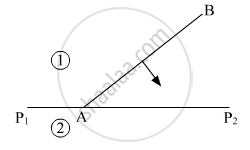Advertisements
Advertisements
Question
Huygens' principle of secondary wavelets may be used to
(a) find the velocity of light in vacuum
(b) explain the particle behaviour of light
(c) find the new position of a wavefront
(d) explain Snell's Law
Solution
(c) find the new position of a wavefront
(d) explain Snell's Law
Huygen's wave theory explains the origin of points for the new wavefront proceeding successively. It also explains the variation in speed of light on moving from one medium to another, i.e. it proves Snell's Law.
APPEARS IN
RELATED QUESTIONS
On the basis of Huygens' wave theory of light prove that velocity of light in a rarer medium is greater than velocity of light in a denser medium.
Using Huygens's construction of secondary wavelets explain how a diffraction pattern is obtained on a screen due to a narrow slit on which a monochromatic beam of light is incident normally.
Explain the construction of plane wavefront using Huygens’ principle.
What is the shape of the wavefront in the following case?
Light emerging out of a convex lens when a point source is placed at its focus.
State Huygens’s principle. Show, with the help of a suitable diagram, how this principle is used to obtain the diffraction pattern by a single slit.
Draw a plot of intensity distribution and explain clearly why the secondary maxima becomes weaker with increasing order (n) of the secondary maxima.
Light waves travel in vacuum along the X-axis. Which of the following may represent the wave fronts?
Define the term wavefront. Using Huygen’s wave theory, verify the law of reflection.
Define the term 'wavefront of light'. A plane wavefront AB propagating from a denser medium (1) into a rarer medium (2) is incident of the surface P1P2 separating the two media as shown in fig.
Using Huygen's principle, draw the secondary wavelets and obtain the refracted wavefront in the diagram.

According to Huygen's construction, relation between old and new wavefront is ______.
Relation between ray and wavefront is ______.
The inverse square law of intensity is valid for a
Huygen's conception of secondary waves ______.
Is Huygen’s principle valid for longitudinal sound waves?
Consider a point at the focal point of a convergent lens. Another convergent lens of short focal length is placed on the other side. What is the nature of the wavefronts emerging from the final image?
Two light beams of intensities in the ratio of 9 : 4 are allowed to interfere. The ratio of the intensity of maxima and minima ______.
How is a wavefront different from a ray?
What type of wavefronts are associated with a source infinity?
Using Huygen's wave theory of light, show that the angle of incidence is equal to the angle of reflection. Draw a neat and labelled diagram.
What type of wavefronts are associated with a point source of light?
